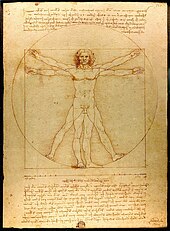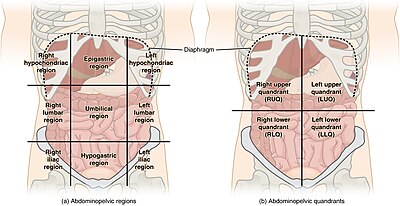নাভি: সংশোধিত সংস্করণের মধ্যে পার্থক্য
নতুন পৃষ্ঠা: {{Redirect|Belly button}} {{Other uses}} {{Infobox anatomy |Name = Navel |Latin = Umbilicus |GraySubject = |GrayPage = |Width = 200 |Image = Ombelico.JPG |Caption... |
(কোনও পার্থক্য নেই)
|
০৮:৪৭, ৩০ ডিসেম্বর ২০১৬ তারিখে সংশোধিত সংস্করণ
| Navel | |
|---|---|
 The human navel is a scar left after the umbilical cord detaches. | |
| বিস্তারিত | |
| পূর্বভ্রূণ | Umbilical cord Ductus venosus[তথ্যসূত্র প্রয়োজন] |
| ধমনী | Umbilical artery |
| শিরা | Umbilical vein |
| শনাক্তকারী | |
| লাতিন | Umbilicus |
| মে-এসএইচ | D014472 |
| টিএ৯৮ | A01.2.04.005 |
| টিএ২ | 261 |
| এফএমএ | FMA:61584 |
| শারীরস্থান পরিভাষা | |
The navel (clinically known as the umbilicus, colloquially known as the belly button, or tummy button) is a scar on the abdomen at the attachment site of the umbilical cord. All placental mammals have a navel, and it is quite conspicuous in humans.[১]
Structure


The umbilicus is used to visually separate the abdomen into quadrants.[২]
The umbilicus is a prominent mark on the abdomen, with its position being relatively consistent among humans. The skin around the waist at the level of the umbilicus is supplied by the tenth thoracic spinal nerve (T10 dermatome). The umbilicus itself typically lies at a vertical level corresponding to the junction between the L3 and L4 vertebrae,[৩] with a normal variation among people between the L3 and L5 vertebrae.[৪]
Parts of the navel include the "umbilical tip", which is the center of the navel often described as a button shape. The "periumbilical skin" surrounds it.[৫] Navels consisting of the umbilical tip protruding past the periumbilical skin have been nicknamed "outies". Outies are often mistaken for umbilical hernias, but are actually a completely different shape with no health concern, unlike an umbilical hernia. The navel (specifically abdominal wall) would be considered an umbilical hernia if the protrusion was 5 centimeters or more. The total diameter of an umbilical hernia is usually 10 centimeters.[৫]
While the shape of the human navel may be affected by long term changes to diet and exercise, unexpected change in shape may be the result of ascites.[৬]
Clinical significance
Disorders
In addition to change in shape being a possible side effect from ascites and umbilical hernias, the navel can be involved in umbilical sinus or fistula, which in rare cases can lead to menstrual or fecal discharge from the navel. Menstrual discharge from the umbilicus is associated with umbilical endometriosis, a rare disorder.[৭][৮]
Other disorders
- Omphalitis, inflammatory condition of umbilicus, usually infected by gram positive bacteria.[তথ্যসূত্র প্রয়োজন]
Surgery
To minimize scarring, the navel is a recommended site of incision for various surgeries, including transgastric appendicectomy,[৯] gall bladder surgery,[১০] and the umbilicoplasty[১১] procedure itself.
Safety
The Heimlich Maneuver, a method of dislodging an object stuck in the throat, is performed just above the navel.[১২]
Society and culture
The public exposure of the male and female midriff and bare navel has been taboo at times in Western cultures, being considered immodest or indecent. It was banned in some jurisdictions, however the community perceptions have changed and exposure of female midriff and navel is more accepted today and in some societies or contexts, it is both fashionable and common, though not without its critics.[১৩]
While the West was relatively resistant to midriff-baring clothing until the 1980s, it has long been a fashion with Indian women.[১৪] The Japanese have long had a special regard for the navel. During the early Jomon period in northern Japan, three small balls indicating the breasts and navel were pasted onto flat clay objects to represent the female body. The navel was exaggerated in size, informed by the belief that the navel symbolizes the center of where life begins.[১৫]
See also
References
- ↑ Kruszelnicki, Karl। "Bellybutton Facts"। ABC Online।
- ↑ "Anatomy & Physiology"। Openstax college at Connexions। সংগ্রহের তারিখ নভেম্বর ১৬, ২০১৩।
- ↑ Ellis, Harold (২০০৬)। Clinical Anatomy: Applied Anatomy for Students and Junior Doctors। New York: Wiley। আইএসবিএন 1-4051-3804-1।[পৃষ্ঠা নম্বর প্রয়োজন]
- ↑ O'Rahilly, Ronan; Müller, Fabiola; Carpenter, Stanley; Swenson, Rand (২০০৪)। "Abdominal walls"। Basic Human Anatomy: A Regional Study of Human Structure। Dartmouth Medical School।
- ↑ ক খ Meier, Donald E.; OlaOlorun, David A.; Omodele, Rachael A.; Nkor, Sunday K.; Tarpley, John L. (২০০১)। "Incidence of Umbilical Hernia in African Children: Redefinition of 'Normal' and Reevaluation of Indications for Repair"। World Journal of Surgery। 25 (5): 645–8। ডিওআই:10.1007/s002680020072। পিএমআইডি 11369993।
- ↑ Herrine, Steven K.। "Ascites"। Merck।
- ↑ Bagade, Pallavi V; Guirguis, Mamdouh M (২০০৯)। "Menstruating from the umbilicus as a rare case of primary umbilical endometriosis: a case report"। Journal of Medical Case Reports। 3: 9326। ডিওআই:10.1186/1752-1947-3-9326। পিএমআইডি 20062755। পিএমসি 2803849
 ।
।
- ↑ D'Alessandro, Donna M. (জুন ২, ২০০৮)। "What's Wrong With His Belly Button?"।টেমপ্লেট:Self-published inlineটেমপ্লেট:MEDRS
- ↑ Kaehler, G.; Schoenberg, M. B.; Kienle, P.; Post, S.; Magdeburg, R. (২০১৩)। "Transgastric appendicectomy"। British Journal of Surgery। 100 (7): 911–5। ডিওআই:10.1002/bjs.9115। পিএমআইডি 23575528। lay summary – Medical News Today (এপ্রিল ১২, ২০১৩)।
- ↑ "SRMC Surgeon Offers Gallbladder Removal through Belly Button Incision with da Vinci® System" (সংবাদ বিজ্ঞপ্তি)। Southeastern Health। ডিসেম্বর ৯, ২০১৩। সংগ্রহের তারিখ আগস্ট ১৬, ২০১৫।
- ↑ Bruekers, Sven E.; van der Lei, Berend; Tan, Tik L.; Luijendijk, Roland W.; Stevens, Hieronymus P. J. D. (২০০৯)। "'Scarless' Umbilicoplasty"। Annals of Plastic Surgery। 63 (1): 15–20। ডিওআই:10.1097/SAP.0b013e3181877b60। পিএমআইডি 19546666।
- ↑ টেমপ্লেট:MedlinePlusEncyclopedia
- ↑ "New code may reveal navel"। Mohave Daily Miner। ২৪ মার্চ ১৯৮৫। সংগ্রহের তারিখ ২০ এপ্রিল ২০১২।
- ↑ Banerjee, Mukulika & Miller, Daniel (2003) The Sari. Oxford; New York: Berg ISBN 1-85973-732-3[পৃষ্ঠা নম্বর প্রয়োজন]
- ↑ Naumann, Nelly (২০০০)। "First Indications of Symbolic Expression"। Japanese Prehistory: The Material and Spiritual Culture of the Jōmon Period। Otto Harrassowitz Verlag। পৃষ্ঠা 114–5। আইএসবিএন 978-3-447-04329-8।
Further reading
- Moreau, Corrie S.; Hulcr, Jiri; Latimer, Andrew M.; Henley, Jessica B.; Rountree, Nina R.; Fierer, Noah; Lucky, Andrea; Lowman, Margaret D.; Dunn, Robert R. (২০১২)। "A Jungle in There: Bacteria in Belly Buttons are Highly Diverse, but Predictable"। PLoS ONE। 7 (11): e47712। ডিওআই:10.1371/journal.pone.0047712। পিএমআইডি 23144827। পিএমসি 3492386
 । বিবকোড:2012PLoSO...747712H।
। বিবকোড:2012PLoSO...747712H। - Gabriele, Raimondo; Conte, Marco; Egidi, Federico; Borghese, Mario (২০০৫)। "Umbilical metastases: current viewpoint"। World Journal of Surgical Oncology। 3 (1): 13। ডিওআই:10.1186/1477-7819-3-13। পিএমআইডি 15723695। পিএমসি 552325
 ।
। - Piskun, Gregory; Rajpal, Sanjeev (১৯৯৯)। "Transumbilical Laparoscopic Cholecystectomy Utilizes No Incisions Outside the Umbilicus"। Journal of Laparoendoscopic & Advanced Surgical Techniques। 9 (4): 361–4। ডিওআই:10.1089/lap.1999.9.361। পিএমআইডি 10488834।
- Craig, Stefan B.; Faller, Mary S.; Puckett, Charles L. (২০০০)। "In Search of the Ideal Female Umbilicus"। Plastic and Reconstructive Surgery। 105 (1): 389–92। ডিওআই:10.1097/00006534-200001000-00062। পিএমআইডি 10627008।
- "New meaning to 'navel-gazing': Scientists study belly button bacteria"। Body Odd। NBC News। এপ্রিল ১৪, ২০১১।
- "Belly Button Biodiversity Project"।
